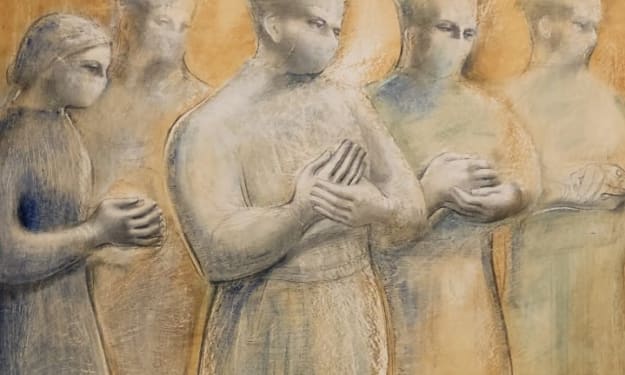Looking up at art
There is more than one way of seeing art and appreciating artistic work

Everyone sees paintings and other artworks differently, and we all have our own tastes and preferences, but this does not stop us from looking beyond the obvious aesthetic value of a picture in order to gain a better understanding of what the artist was trying to say. Getting more out of art can also help us feel healthier, happier and more motivated.
I have reposted this article for the new Art community
Take this image from a painting by Constable, The Cornfield. If you have seen it in the National Gallery in London, you may not remember it, because it is displayed in the same small gallery as Constable’s more famous work The Hay Wain. If you get a chance to see the painting it is worth a closer look while others are checking out Constable's better known canvass.
I have no schooling in art history so I can only comment on what I see, or what I might have read on the information panel or gallery website about any work. These are my thoughts, only. What do you think? Please leave your comments at the end of this article.
First thing you can’t help but notice about The Cornfield is that it is a typical rural scene, of a kind Constable is well known for. Fields, trees, animals, blue sky and clouds. The sort of thing you will see on greetings cards, chocolate boxes and jigsaw puzzles. Rural scenes always have their own appeal. Try looking beyond the pretty countryside, however, and there is a whole world to be revealed inside the painting.
You might like to start by looking at the more prominent features. You can see there is a country lane leading through two rows of trees and onto a field of corn. A small group of sheep in the road and a dog appear to be waiting to herd the sheep on their way down the lane. If you follow the dog’s gaze you will see that the reason the dog is waiting is that there is a boy, presumably the dog’s owner or master, taking a drink at the brook that runs to the side of the lane. All this, we can take in with a single glance. So much for the obvious. What about the rest of the story?
The boy is taking a drink from the brook, which has been dammed, perhaps for the purpose of watering livestock. His brightly coloured clothing makes him stand out from the surrounding homogenous greens and browns and draws our attention. As our eye is drawn to this feature in the painting, it is led to the other details, such as the man standing at the edge of the field, the other laborers and the buildings and river in the distance. With these workaday details against the backdrop of fields, trees and the stream, we have an evocative image of country folk at work in their natural surroundings. The scene must have been set in late summer, with the corn ripe and ready to harvest. The weather is bright but cloudy with a skyscape as full of detail as the landscape below. The light from the sun illuminates some features of the paintings and casts shadow over others.
Look closer and you will find more. The drinking boy, who must be the main subject of the painting, appearing as he does in the foreground, is in danger of being lost in the vastness of land and sky. Looks like the artist may have used some tricks of the trade in order to make him stand out more. Firstly, the figure appears much larger than you might expect. Try comparing the size of the boy to the size of the dog and the sheep nearby. What’s more, the colors used for the boy’s clothing, already mentioned, are loud and bright, particularly the red top and bright white sleeves. These colors really do stand out from the greens, browns and blacks of the background. Even the water is a dark blue, almost black in the shade, although there is a bright patch of reflected sunlight on the water placed as if to highlight the boy’s face. I am not sure if this is clear from the online image so you might need to see the painting itself to appreciate such features.
Innovative use of light and color are known to be trademarks of Constable’s painting style. This can be seen throughout this work. See how the artist has highlighted the boy and his dog and other important features, while veiling the sheep in shadow. A few of the sheep walking at the back of the column are picked out with enough sunlight to highlight sufficient detail to let you know what this feature of the painting is, and to give you an idea of the relative importance of this feature to the overall story. Once you can see that they are sheep, there is no need for further detail, hence the shadow over the remaining flock.
All this is mere observation and speculation on my part. I have never read anything about this painting and had not looked at it (that I can remember) before choosing it from the universe of paintings available to see on the world wide web, albeit from a purely second-hand and two-dimensional perspective. My first sight of this image was therefore a false one and I could not fully appreciate the work until I had been to see it at the National Gallery in London, a short walk from my then place of work.
Works such as this can have a strong effect on our feelings, our emotions. This is perhaps one reason for the popularity of Constable and the strength of images taken from his paintings when used in marketing. We see an image of a rural landscape that can make us feel as if we are there, in the landscape. Perhaps it reminds us of a vacation in the countryside, a weekend walk, or a visit to a remote rural setting. We don’t just see the cornfield, we feel it, feel that we are almost there, in the picture (although those who live and work on the land may feel something different).
For some reason that is difficult to explain, such a feeling of being there is stronger than any feeling you might have from seeing a large photographic poster of a similar scene. It is not just the contemporary costume and the details like the plow, waiting patiently outside the corn field to be drawn by horse and guided by the plowman next springtime. There is much, much more to it than that. I can only suggest that the composition, the painting technique, the vision and perhaps the empathy of Constable for his subject, have somehow combined to create an almost magical glimpse into a past rural life. A life where time goes slowly, nobody is stressed by the daily commute, plowmen follow horses, corn ripens in the summer and boys drive sheep with their dogs and have time to stop at a brook for a drink. Was that really what rural life was like in 1826? Probably not for the average farm hand or shepherd boy but this painting certainly conveys the myth of an idyllic rural life.
If you are ever in London, near Trafalgar Square or theatreland around Leicester Square, why not drop by the National Gallery, which is free to visitors? Ask for the Constable gallery and take a look at this and other paintings. What can you see when you look up at these paintings? If you can’t get to London, take a look at the image above, and perhaps some other paintings online.
Let me know what you can see. If you can see something I have not mentioned, please share and let me know if you liked this article. If there is enough interest, I will continue with this theme as a series.
About the Creator
Raymond G. Taylor
Author based in Kent, England. A writer of fictional short stories in a wide range of genres, he has been a non-fiction writer since the 1980s. Non-fiction subjects include art, history, technology, business, law, and the human condition.






Comments
There are no comments for this story
Be the first to respond and start the conversation.